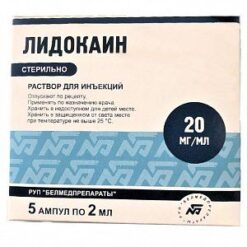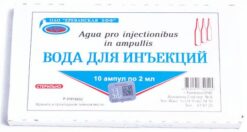No products in the cart.
Reamberine, 1.5% 200 ml
€6.46 €5.65
Out of stock
(E-mail when Stock is available)
EAN: 4603191000604
SKU: 212622
Categories: Anesthesia and resuscitation, Anesthesia solutions, Medicine
Description
Pharmacotherapeutic group: solutions affecting water-electrolyte balance.
The ATX code: B05BB
Pharmacological properties
Pharmacodynamics
REAMBERIN® has an anti-hypoxic and antioxidant effect, positively influencing aerobic processes in the cell, reducing the production of free radicals and restoring the energy potential of cells.
The drug activates Krebs cycle enzymatic processes, promotes utilization of fatty acids and glucose in cells, normalizes acid-base balance and blood gas composition. It has a moderate diuretic effect.
Pharmacokinetics
In intravenous administration the drug is quickly utilized and does not accumulate in the body.
Indications
Indications
REAMBERIN® is used in adults and children from 1 year of age as an antihypoxic and detoxifying agent for acute endogenous and exogenous intoxications of various etiologies.
Pharmacological effect
Pharmacological effect
Pharmacotherapeutic group: solutions affecting water and electrolyte balance.
ATX code: В05ВВ
PHARMACOLOGICAL PROPERTIES
Pharmacodynamics
REAMBERIN® has an antihypoxic and antioxidant effect, having a positive effect on aerobic processes in the cell, reducing the production of free radicals and restoring the energy potential of cells.
The drug activates the enzymatic processes of the Krebs cycle and promotes the utilization of fatty acids and glucose by cells, normalizes the acid-base balance and gas composition of the blood. Has a moderate diuretic effect.
Pharmacokinetics
When administered intravenously, the drug is quickly utilized and does not accumulate in the body.
Special instructions
Special instructions
Due to the activation of aerobic processes in the body by the drug, a decrease in the concentration of glucose in the blood and the appearance of an alkaline reaction in urine are possible. In patients with diabetes mellitus and patients with reduced glucose tolerance, periodic monitoring of blood glucose concentrations is required. If the color of the solution changes or there is a precipitate, the use of the drug is unacceptable.
Effect on the ability to drive vehicles and machinery It is not recommended to drive vehicles or operate machinery during a course of treatment with REAMBERIN®.
Active ingredient
Active ingredient
Meglumine sodium succinate
Composition
Composition
Active ingredients:
meglumine sodium succinate – 15.0 g,
obtained according to the following formula:
N-methylglucamine (meglumine) – 8.725 g,
succinic acid – 5.280 g;
Excipients:
sodium chloride – 6.0 g,
potassium chloride – 0.30 g,
magnesium chloride (in terms of anhydrous) – 0.12 g,
sodium hydroxide – 1.788 g,
water for injection up to 1.0 l
Contraindications
Contraindications
Individual intolerance, condition after traumatic brain injury, accompanied by cerebral edema, acute renal failure, chronic kidney disease (stage 5, glomerular filtration rate less than 15 ml/min), pregnancy, breastfeeding period.
With caution
With alkalosis, renal failure.
Use during pregnancy and breastfeeding The use of REAMBERIN® during pregnancy and breastfeeding is contraindicated due to the lack of clinical studies in these groups of patients.
Side Effects
Side Effects
According to the World Health Organization, adverse effects are classified according to their frequency as follows:
– very frequent (≥ 1/10);
– frequent (from ≥ 1/100 to < 1/10);
– infrequent (from ≥ 1/1000 to < 1/100);
– rare (from ≥ 1/10000 to < 1/1000);
– very rare (< 1/10000);
– frequency unknown (cannot be determined based on available data).
If the drug is administered quickly, undesirable effects are possible.
General disorders and disorders at the injection site: very rarely – hyperthermia, chills, sweating, weakness, pain at the injection site, edema, hyperemia, phlebitis.
Immune system disorders: very rarely – allergic reactions, angioedema, anaphylactic shock.
Disorders of the skin and subcutaneous tissues: very rarely – allergic rash, urticaria, itching.
Disorders of the respiratory system, chest and mediastinal organs: very rarely – shortness of breath, dry cough.
Cardiac disorders: very rarely – tachycardia, palpitations, shortness of breath, pain in the heart, chest pain.
Vascular disorders: very rarely – arterial hypotension/hypertension, short-term reactions in the form of a burning sensation and redness of the upper body.
Gastrointestinal disorders: very rarely – nausea, vomiting, metallic taste in the mouth, abdominal pain, diarrhea.
Nervous system disorders: very rarely – dizziness, headache, convulsions, tremor, paresthesia, agitation, anxiety.
To avoid the occurrence of undesirable effects, it is recommended to adhere to the dosage regimen and rate of administration of the drug.
If adverse reactions occur, it is recommended to reduce the rate of drug administration.
If any of the undesirable effects indicated in the instructions get worse or you notice any other undesirable effects not listed in the instructions, tell your doctor.
Interaction
Interaction
The drug combines well with antibiotics, water-soluble vitamins, and glucose solution. Combined with drugs containing phosphates, sulfates or tartrates. It is not recommended to mix it in the bottle or container with other medications. Intravenous administration of REAMBERIN® simultaneously with calcium preparations is unacceptable due to possible precipitation of calcium succinate.
Storage conditions
Storage conditions
In a place protected from light at a temperature not exceeding 25 ° C. Freezing of the drug is allowed. Keep out of the reach of children.
Shelf life
Shelf life
5 years in glass bottles, 3 years in polymer containers made of multilayer polyolefin film. Do not use after the expiration date stated on the package.
Manufacturer
Manufacturer
Polisan NTFF LLC, Russia
Additional information
| Shelf life | 5 years in glass bottles, 3 years in polymer containers of multi-layer polyolefin film. Do not use after the expiration date stated on the package. |
|---|---|
| Conditions of storage | In a dark place at a temperature not exceeding 25 °С. Freezing of the drug is allowed. Keep out of reach of children. |
| Manufacturer | Polysan NTFF LLC, Russia |
| Medication form | solution for infusion |
| Brand | Polysan NTFF LLC |
Related products
Buy Reamberine, 1.5% 200 ml with delivery to USA, UK, Europe and over 120 other countries.



